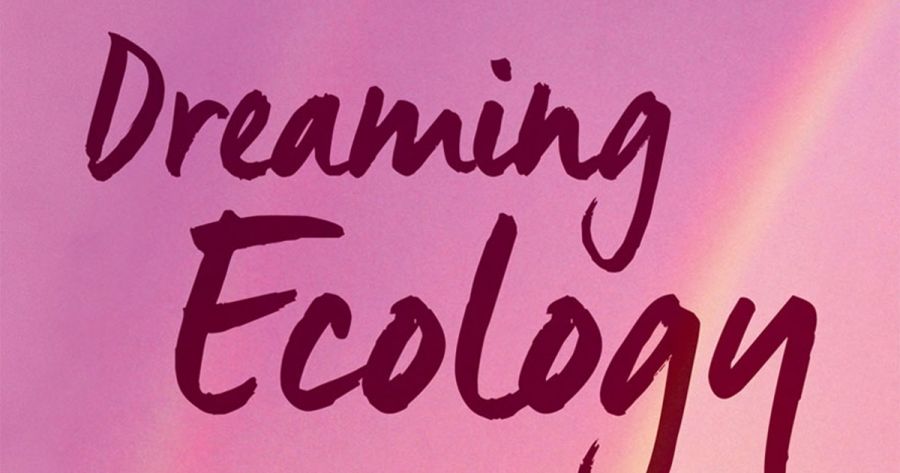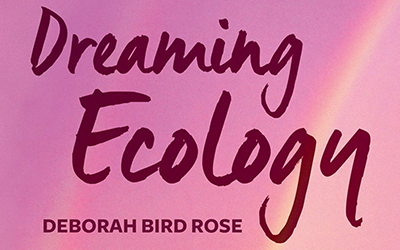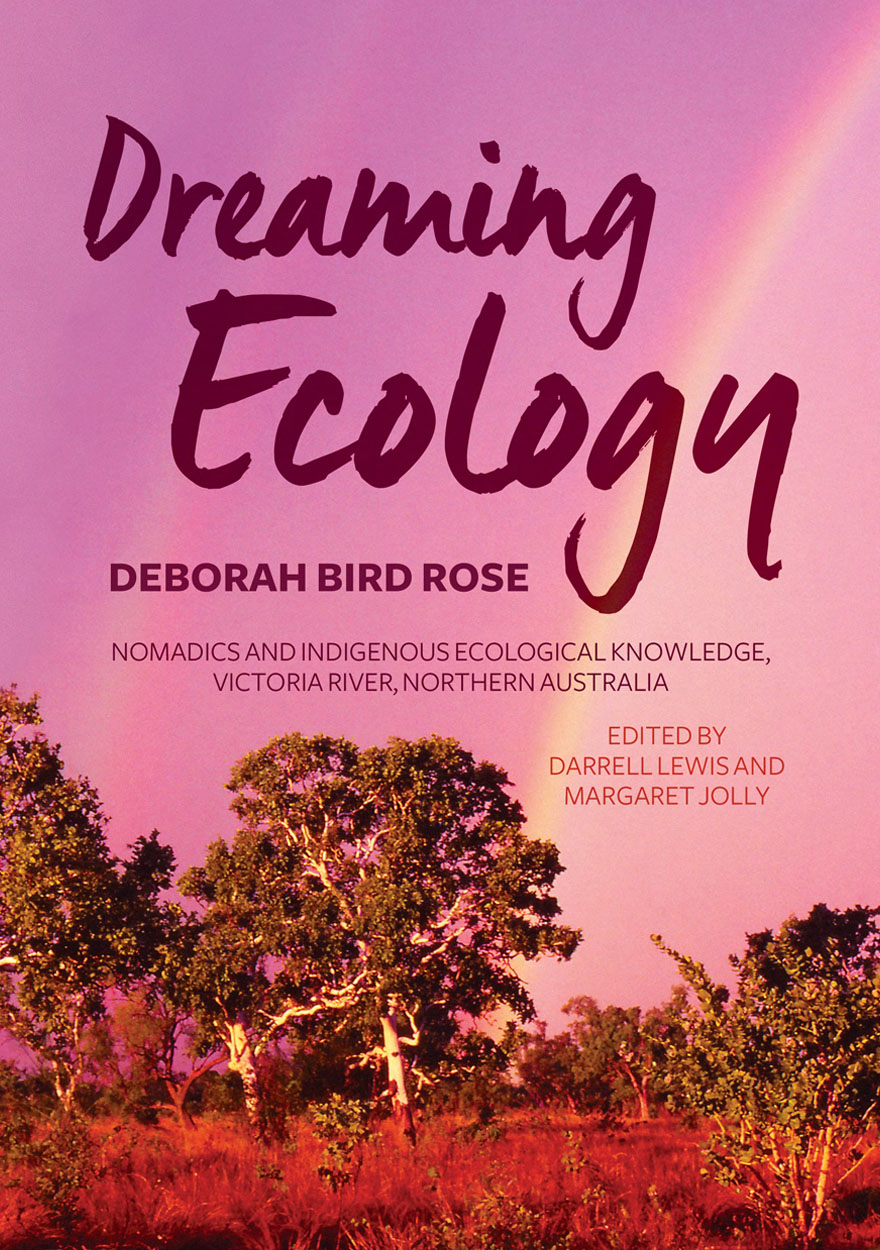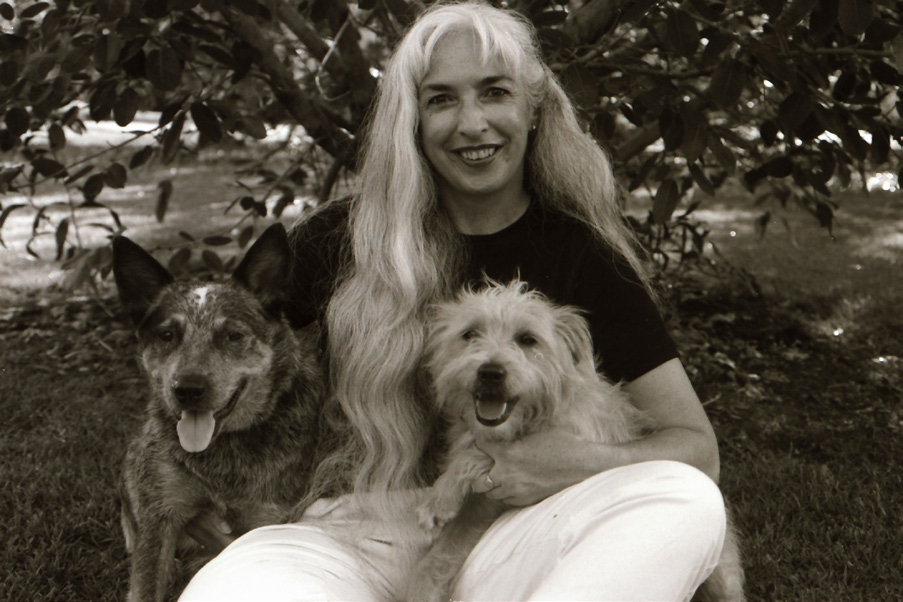
- Free Article: No
- Contents Category: Indigenous Studies
- Review Article: Yes
- Article Title: Chains of connection
- Article Subtitle: Anthropology at its best
- Online Only: No
- Custom Highlight Text:
Dreaming Ecology is the posthumous third volume in a trilogy that also comprises Deborah Bird Rose’s earlier anthropological study Dingo Makes Us Human (1992) and Hidden Histories (1991), an account of the recent his-tory of Aboriginal people in the Victoria River District (VRD) region in the north-western corner of the Northern Territory. As an anthropological neophyte, I came across her briefly in 1994 during the Palm Valley Land Claim in Central Australia, in her role as anthropologist assisting the Northern Territory Aboriginal Land Commissioner. Although by the time of her death in 2018 she had worked on nearly twenty Aboriginal land claims, her own anthropological research diverged from Australian anthropology’s preoccupation for nearly fifty years with Indigenous land tenure systems dictated by the land claim and native title claim process.
- Featured Image (400px * 250px):

- Alt Tag (Featured Image): Stephen Bennetts reviews ‘Dreaming Ecology: Nomadics and Indigenous ecological knowledge, Victoria River, Northern Australia’ by Deborah Bird Rose
- Book 1 Title: Dreaming Ecology
- Book 1 Subtitle: Nomadics and Indigenous ecological knowledge, Victoria River, Northern Australia
- Book 1 Biblio: ANU Press, $59.99 pb, 337 pp
- Book 1 Cover Small (400 x 600):

- Book 1 Cover (800 x 1200):

Relying at first on conventional ethnobotanical survey methodologies, Rose found that ‘in working through piles of specimens with teachers like Jessie, Dora and Hobbles, it became clear that people in their age range (over sixty) easily identified well over 150 plants and knew of more for which I had no specimens’. From 1986 to 1991, she introduced an innovative biographical-ecological mapping technique:
I decided to work with maps to take memory journeys and revisit the places people had walked in their youth. I sought to document the foods they had eaten as they travelled. The maps document resources in some areas for which no scientific surveys have been conducted. In addition, they document distributions from a time which is no longer accessible and document former abundance of some species which are now absent entirely or present only sporadically and in scarce amounts.
Rose’s background – she was the daughter of a Protestant minister and granddaughter of Congregational and Unitarian ministers – seems to have equipped her well for her powerful cross-cultural dialogue with Aboriginal cosmology. Indigenous totemism rejects the Western division between culture and nature and Christianity’s notion of a transcendent plenum beyond the material world, and instead proposes an immanent system of connectivity and kinship that brings not only people but also plant and animal species into connection, and in which human subjects are consubstantial with the natural world rather than separated from it.
Flesh is shared across species so that human life is implicated in the lives of other species. Subjectivity is located within the site of the body, within the bodies of other people and other species and within the world in trees, rock holes, on rock walls and so on.
In her Aboriginal teachers’ world view, Dreaming Women placed baby spirits in particular locations during the Dreamtime; later they seek to be born by attaching themselves to animals, which are then hunted by the baby’s father and eaten by its mother, with the spirit’s arrival in the mother’s womb often signalled by vomiting: ‘chains of connection give the person a genealogy that not only includes parents, but also Country, dreaming sources and the mediating animal’. Rose provides an emblematic example of a man who
was a barramundi before he became a person. His father speared the fish, his mother ate some, then the spirit became the baby, who grew into the man known as Hobbles Danaiyarri. On his right temple he had a small mark where his father speared the fish … A group of Aboriginal people had been fishing and were shot by white fellows. One of the men died in the water. His spirit became a barramundi: the barramundi became Hobbles.
Rose was herself assigned to the flying fox matrilineal totem (ngurlu), and Shimmer, the book she completed only a few weeks before her death, reflects her long fascination with the species, while Wild Dog Dreaming similarly explores human connections with the non-human.
 Deborah Bird Rose, 1998 (photo by Darrell Lewis via Duke University Press)
Deborah Bird Rose, 1998 (photo by Darrell Lewis via Duke University Press)
A melancholy feature of the anthropological vocation (captured so well in Lévi-Strauss’s memoir Tristes Tropiques) is the elegiac sense of loss that accompanies the passing of ethnographic collaborators who have handed on to us their testimony of bygone and now irrecoverable worlds. Rose’s writing bears witness to the ecological and cultural losses inflicted on the First Peoples and ecology of the VRD by frontier violence, ecocide, and genocide, as ‘colonising society laid a grid of cattle stations over [Aboriginal] countries’. Cattle grazing has had a devastating effect on the VRD environment, wiping out many once familiar plant species. Although some of Rose’s oldest teachers had seen bandicoots, bilbies, brushtail possums, and quolls in their youth, no one had seen any of these four animals in decades.
In a stunning Indigenous inversion of the colonial concept of civilising ‘land improvement’, some of Rose’s collaborators referred to areas of ecological devastation caused by overgrazing as ‘Wild Country’. In Hobbles Danaiyarri’s view, ‘before kartiya, blackfellas bin just walking round organising the Country’, the apparent implication being that, in contrast to Aboriginal land management practices, kartiya had been ‘walking around and disorganising the Country ever since they came here’.
The idea of extinction looms large in Rose’s work, no more so than in her notion of ‘double death’: ‘the first death is ordinary death; the second death is destruction of the capacity for life to transform death into life. Languages obliterated and maybe gone forever and clans or tribes eradicated and maybe gone forever are examples of double death.’ In one dispiriting passage, Rose cites several cases of now extinct plant or animal species that are totemic relations of people still alive today: ‘the people live and their totemic sites, songs, designs and practices live, but the animals themselves, the non-human descendants of the ancestral totemic figures are gone’.
Rose’s decades-long research on Aboriginal plant use appears nowhere to have uncovered evidence to substantiate Bruce Pascoe’s recent claim that Aboriginal people practised European-style agriculture, although co-editor Margaret Jolly appears in her prologue to give some credence to this notion. Her otherwise exemplary exegesis will certainly assist the non-specialist reader in navigating the key themes of this rich but at times philosophically dense text. Deborah Bird Rose’s sympathetic and sensitive engagement with the life worlds of traditional Aboriginal people seems to me to represent anthropology at its best, and it is difficult to argue with the words of her second co-editor (and ex-partner) Darrell Lewis: ‘[Debbie’s] passing is a major loss to this country, but her numerous writings dedicated to social and ecological justice and to helping bridge the gap between Aboriginal and settler Australians are an ongoing gift to this country, and to the wider world.’


Comments powered by CComment